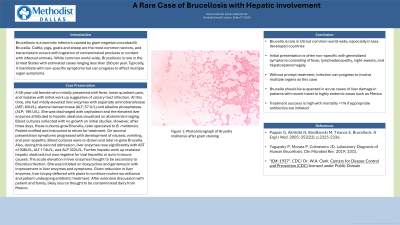Tuesday Poster Session
Category: Liver
P4714 - A Rare Case of Brucellosis With Hepatic Involvement
Tuesday, October 29, 2024
10:30 AM - 4:00 PM ET
Location: Exhibit Hall E

Has Audio

Dillon Drab, MD
Methodist Dallas Medical Center
Grand Prairie, TX
Presenting Author(s)
Dillon Drab, MD1, Farhan Abdullah, MD2, Kinnari Modi, DO3
1Methodist Dallas Medical Center, Grand Prairie, TX; 2Methodist Dallas Medical Center, Dalls, TX; 3Methodist Dallas Medical Center, Dallas, TX
Introduction: Brucellosis is a zoonotic infection caused by gram negative coccobacilli Brucella. Cattle, pigs, goats and sheep are the most common vectors, and transmission occurs with ingestion of contaminated products or contact with infected animals. While common world-wide, Brucellosis is rare in the United States with estimated cases ranging less than 200 per year. Typically, it manifests with non-specific symptoms but can progress to affect multiple organ symptoms.
Case Description/Methods: A 58-year-old female who initially presented with fever, lower quadrant pain, and malaise with initial work up suggestive of urinary tract infection. At this time, she had mildly elevated liver enzymes with aspartate aminotransferase (AST; 83U/L), alanine transaminase (ALT; 57 U/L) and alkaline phosphatase (ALP; 196 U/L). She was discharged with cephalexin and the elevated liver enzymes attributed to hepatic steatosis visualized on abdominal imaging. Blood cultures collected with no growth on initial studies. However, after three days, these cultures grow Brucella, later speciated to B. melitensis. Patient notified and instructed to return for treatment. On second presentation symptoms progressed with development of nausea, vomiting, and poor appetite. Blood cultures were re-drawn and later re-grew Brucella. Also, during this second admission, liver enzymes rose significantly with AST of 308U/L, ALT 174U/L, and ALP 322U/L. Further hepatic work up revealed hepatic steatosis but was negative for viral hepatitis or auto-immune causes. The acute elevation in liver enzymes thought to be secondary to Brucella infection. She was initiated on doxycycline and gentamycin with improvement in liver enzymes and symptoms. Given reduction in liver enzymes, liver biopsy deferred with plans to continue routine surveillance and patient undergoing antibiotic treatment. After extensive discussion with patient and family, likely source thought to be contaminated dairy from Mexico.
Discussion: While Brucella is common world-wide, it is rare in the United States given current animal policies. Initial presentation is often non-specific with generalized symptoms but if not promptly treated will progress to involve other organs such as this case with hepatic involvement. Generally, treatment success is high with mortality of < 1% if patients are administered appropriate antibiotics.
Disclosures:
Dillon Drab, MD1, Farhan Abdullah, MD2, Kinnari Modi, DO3. P4714 - A Rare Case of Brucellosis With Hepatic Involvement, ACG 2024 Annual Scientific Meeting Abstracts. Philadelphia, PA: American College of Gastroenterology.
1Methodist Dallas Medical Center, Grand Prairie, TX; 2Methodist Dallas Medical Center, Dalls, TX; 3Methodist Dallas Medical Center, Dallas, TX
Introduction: Brucellosis is a zoonotic infection caused by gram negative coccobacilli Brucella. Cattle, pigs, goats and sheep are the most common vectors, and transmission occurs with ingestion of contaminated products or contact with infected animals. While common world-wide, Brucellosis is rare in the United States with estimated cases ranging less than 200 per year. Typically, it manifests with non-specific symptoms but can progress to affect multiple organ symptoms.
Case Description/Methods: A 58-year-old female who initially presented with fever, lower quadrant pain, and malaise with initial work up suggestive of urinary tract infection. At this time, she had mildly elevated liver enzymes with aspartate aminotransferase (AST; 83U/L), alanine transaminase (ALT; 57 U/L) and alkaline phosphatase (ALP; 196 U/L). She was discharged with cephalexin and the elevated liver enzymes attributed to hepatic steatosis visualized on abdominal imaging. Blood cultures collected with no growth on initial studies. However, after three days, these cultures grow Brucella, later speciated to B. melitensis. Patient notified and instructed to return for treatment. On second presentation symptoms progressed with development of nausea, vomiting, and poor appetite. Blood cultures were re-drawn and later re-grew Brucella. Also, during this second admission, liver enzymes rose significantly with AST of 308U/L, ALT 174U/L, and ALP 322U/L. Further hepatic work up revealed hepatic steatosis but was negative for viral hepatitis or auto-immune causes. The acute elevation in liver enzymes thought to be secondary to Brucella infection. She was initiated on doxycycline and gentamycin with improvement in liver enzymes and symptoms. Given reduction in liver enzymes, liver biopsy deferred with plans to continue routine surveillance and patient undergoing antibiotic treatment. After extensive discussion with patient and family, likely source thought to be contaminated dairy from Mexico.
Discussion: While Brucella is common world-wide, it is rare in the United States given current animal policies. Initial presentation is often non-specific with generalized symptoms but if not promptly treated will progress to involve other organs such as this case with hepatic involvement. Generally, treatment success is high with mortality of < 1% if patients are administered appropriate antibiotics.
Disclosures:
Dillon Drab indicated no relevant financial relationships.
Farhan Abdullah indicated no relevant financial relationships.
Kinnari Modi indicated no relevant financial relationships.
Dillon Drab, MD1, Farhan Abdullah, MD2, Kinnari Modi, DO3. P4714 - A Rare Case of Brucellosis With Hepatic Involvement, ACG 2024 Annual Scientific Meeting Abstracts. Philadelphia, PA: American College of Gastroenterology.
